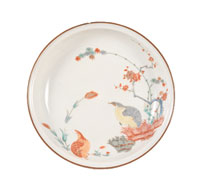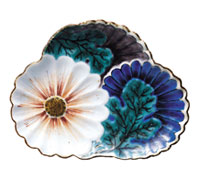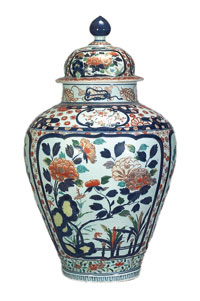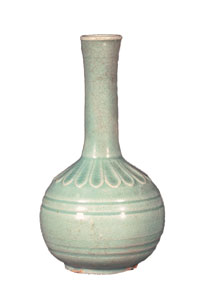Exhibitions Schedule in 2017-2018
April 1st - May 14th, 2017
30th Anniversary Special Exhibition: Kakiemon
 The core of our collection at the Toguri Museum of Art is fine Imari ware, the first porcelain ever made in Japan. The history of Imari ware began early in the 17th century in the town of Arita, in what is now Saga Prefecture. Soon after, in the middle of the 17th century, there were great advances in technology, including improvements in the ability to produce the color red in overglaze decoration, an innovation in which the Kakiemon family kiln is known to have played a major role. A new style of decoration arose that features colorful overglaze designs with the predominant use of this vibrant new red, beautifully offset by a milky white porcelain base called nigoshide. This combination came to be called the Kakiemon style. A great many such works were exported overseas, where they enjoyed lasting popularity among the nobility of Europe. During the 18th century, however, following increased competition from China and a decline in export opportunities, the secret for making the nigoshide base was lost. It was only after World War II that the 12th and 13th hereditary heirs of the Kakiemon family were able to revive the long-forgotten technology. The 14th hereditary heir, too, built on the accomplishments of his predecessors to create beautiful works with a new sensibility and remarkably life-like designs. In 2014, Sakaida Kakiemon XV assumed position as current heir of the family kiln. Today, he creates beautiful works that appeal to the present while respecting and preserving tradition. For this special exhibition to commemorate the 30th anniversary of the founding of our museum, we bring you never-before-seen works by Sakaida Kakiemon XV, along with exceptional pieces that demonstrate the ongoing mastery of the Kakiemon family in modern times. In addition, we present a gorgeous selection of Edo-era masterpieces from our own collection. We hope you will enjoy this rare opportunity to trace the entire Kakiemon history, from the development of this superlative technology in the Edo period to its continuation and mastery in our own times.
The core of our collection at the Toguri Museum of Art is fine Imari ware, the first porcelain ever made in Japan. The history of Imari ware began early in the 17th century in the town of Arita, in what is now Saga Prefecture. Soon after, in the middle of the 17th century, there were great advances in technology, including improvements in the ability to produce the color red in overglaze decoration, an innovation in which the Kakiemon family kiln is known to have played a major role. A new style of decoration arose that features colorful overglaze designs with the predominant use of this vibrant new red, beautifully offset by a milky white porcelain base called nigoshide. This combination came to be called the Kakiemon style. A great many such works were exported overseas, where they enjoyed lasting popularity among the nobility of Europe. During the 18th century, however, following increased competition from China and a decline in export opportunities, the secret for making the nigoshide base was lost. It was only after World War II that the 12th and 13th hereditary heirs of the Kakiemon family were able to revive the long-forgotten technology. The 14th hereditary heir, too, built on the accomplishments of his predecessors to create beautiful works with a new sensibility and remarkably life-like designs. In 2014, Sakaida Kakiemon XV assumed position as current heir of the family kiln. Today, he creates beautiful works that appeal to the present while respecting and preserving tradition. For this special exhibition to commemorate the 30th anniversary of the founding of our museum, we bring you never-before-seen works by Sakaida Kakiemon XV, along with exceptional pieces that demonstrate the ongoing mastery of the Kakiemon family in modern times. In addition, we present a gorgeous selection of Edo-era masterpieces from our own collection. We hope you will enjoy this rare opportunity to trace the entire Kakiemon history, from the development of this superlative technology in the Edo period to its continuation and mastery in our own times.
May 27th - September 2nd, 2017
Ko-Imari Masterpieces of the 17th Century
 When you look at a dish, what do you notice? Do you think about what type of ware it is, or what it was used for? Or do you look at the colors and patterns? There are truly so many ways to appreciate ceramics. Even within Imari ware, there is a great range of shapes: round dishes and square dishes, even dishes in the shape of flowers. The degree of whiteness in the porcelain base, too, varies from piece to piece. In some works, the base porcelain has a blueish tint while others are milky white. If you stop to think about why such differences exists, you are bound to make new discoveries. And if you try a new approach, a dish that you might have overlooked in the past may suddenly have new appeal. It might even speak to you in that special way. In 17th century Ko-Imari, which is the focus of this exhibition, there was tremendous variety in the works produced as the nascent porcelain industry evolved from its very beginnings to achieve dramatic advancements in techniques and design. This exhibition is organized into 15 special themes, including “shape” and “whiteness of the base,” to encourage you to explore and enjoy dishes in new ways. With approximately 80 fine works on view, there’s bound to be at least one that will speak to you in a special way.
When you look at a dish, what do you notice? Do you think about what type of ware it is, or what it was used for? Or do you look at the colors and patterns? There are truly so many ways to appreciate ceramics. Even within Imari ware, there is a great range of shapes: round dishes and square dishes, even dishes in the shape of flowers. The degree of whiteness in the porcelain base, too, varies from piece to piece. In some works, the base porcelain has a blueish tint while others are milky white. If you stop to think about why such differences exists, you are bound to make new discoveries. And if you try a new approach, a dish that you might have overlooked in the past may suddenly have new appeal. It might even speak to you in that special way. In 17th century Ko-Imari, which is the focus of this exhibition, there was tremendous variety in the works produced as the nascent porcelain industry evolved from its very beginnings to achieve dramatic advancements in techniques and design. This exhibition is organized into 15 special themes, including “shape” and “whiteness of the base,” to encourage you to explore and enjoy dishes in new ways. With approximately 80 fine works on view, there’s bound to be at least one that will speak to you in a special way.
September 15th - December 20th, 2017
Ko-Imari Masterpieces of the 18th Century
 The 17th century saw the advent of Imari ware as Japan’s first domestic porcelain, as well as sweeping technological innovations that carried the craft to its zenith in manufacturing methods. The many superb works made at that time were luxury items that only the upper reaches of society could afford. In the 18th century, however, the market for Imari ware changed and expanded. The kilns now made products for a wider base of users, ranging from luxury ware to more affordable items. On the one hand, there were the great vases and jars made for export, now in even larger sizes, that were so favored by the nobility of Europe for display in their castles and manor homes. But the kilns were now also making products for the domestic market, which expanded during the prosperous Genroku era (1688–1704). These new products include splendid dishes in the Kinrande style, which features rich colors and the lavish use of gold, which were popular with wealthy merchants who would bring them out for use on special occasions. As food culture developed and spread, the kilns also moved into larger-scale production of simpler, useful blue-and-white dishes and bowls. The potters skillfully adjusted their designs and product line to appeal to different users, and to suit the fashions of the times. These changes helped popularize Imari ware, bringing this beautiful porcelainware into the lives of a greater number of people. In this exhibition, we present approximately 80 fine works, ranging from tiny dishes that could fit into the palm of your hand to large vases over 70 cm tall. Some of the pieces you will see are being exhibited in our museum for the first time. As you appreciate and compare the various shapes, designs, and decorative elements, we hope you will make new discoveries, experiencing for yourself the many reasons that 18th century Imari ware has captivated so many people in so many places across so many different times.
The 17th century saw the advent of Imari ware as Japan’s first domestic porcelain, as well as sweeping technological innovations that carried the craft to its zenith in manufacturing methods. The many superb works made at that time were luxury items that only the upper reaches of society could afford. In the 18th century, however, the market for Imari ware changed and expanded. The kilns now made products for a wider base of users, ranging from luxury ware to more affordable items. On the one hand, there were the great vases and jars made for export, now in even larger sizes, that were so favored by the nobility of Europe for display in their castles and manor homes. But the kilns were now also making products for the domestic market, which expanded during the prosperous Genroku era (1688–1704). These new products include splendid dishes in the Kinrande style, which features rich colors and the lavish use of gold, which were popular with wealthy merchants who would bring them out for use on special occasions. As food culture developed and spread, the kilns also moved into larger-scale production of simpler, useful blue-and-white dishes and bowls. The potters skillfully adjusted their designs and product line to appeal to different users, and to suit the fashions of the times. These changes helped popularize Imari ware, bringing this beautiful porcelainware into the lives of a greater number of people. In this exhibition, we present approximately 80 fine works, ranging from tiny dishes that could fit into the palm of your hand to large vases over 70 cm tall. Some of the pieces you will see are being exhibited in our museum for the first time. As you appreciate and compare the various shapes, designs, and decorative elements, we hope you will make new discoveries, experiencing for yourself the many reasons that 18th century Imari ware has captivated so many people in so many places across so many different times.
January 7th - March 21st, 2018
Beautiful Glazes in Ko-Imari Ware
 Glaze is the glass-like layer that covers the surface of a piece of ceramics. In Japanese, glaze is generally called uwagusuri or yūyaku. Applying glaze does more than simply make the dish more durable and impervious to liquid; the chemical reactions that occur during firing also create textures and colors that add to the beauty of the piece. The four main coatings seen on Edo-era Imari ware are transparent glaze, celadon, a bluish glaze known as ruriyū, and an iron-brown glaze called sabi-yū. Various and differing works were made taking full advantage of the special color and characteristics of each glaze. Some pieces, for example, are completely devoid of painted design, allowing the color and texture of the glaze to draw out the inherent beauty of the shape. In other cases, rich expression is achieved by using multiple glazes on a single piece. In this exhibition, we focus on glazes as we present approximately 80 fine examples of Imari ware. As you see with your own eyes how different works can be depending on the glaze and application techniques used, we hope you will gain new appreciation for glaze and find ever more pleasure in ceramics.
Glaze is the glass-like layer that covers the surface of a piece of ceramics. In Japanese, glaze is generally called uwagusuri or yūyaku. Applying glaze does more than simply make the dish more durable and impervious to liquid; the chemical reactions that occur during firing also create textures and colors that add to the beauty of the piece. The four main coatings seen on Edo-era Imari ware are transparent glaze, celadon, a bluish glaze known as ruriyū, and an iron-brown glaze called sabi-yū. Various and differing works were made taking full advantage of the special color and characteristics of each glaze. Some pieces, for example, are completely devoid of painted design, allowing the color and texture of the glaze to draw out the inherent beauty of the shape. In other cases, rich expression is achieved by using multiple glazes on a single piece. In this exhibition, we focus on glazes as we present approximately 80 fine examples of Imari ware. As you see with your own eyes how different works can be depending on the glaze and application techniques used, we hope you will gain new appreciation for glaze and find ever more pleasure in ceramics.
.jpg)




